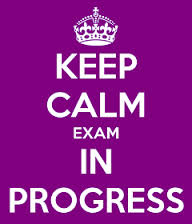Invigilation 101: Thoughts and Observations on best practice
Gerry GibsonHaving served all roles in the invigilation process over the past 9 nine years at HCT, I feel that I’ve got my head around the needs for creating an efficient and relatively painless invigilation experience. For the majority of us, our roles fall into one of three areas: invigilator, head invigilator, and floater. Rather than go through the rules and regulations of the invigilation process that we know all too well (no need to point out the obvious things about mobile phones and bags at the front of the classroom), I’d like to present my observations based on my invigilation experience.

1) How the Head Invigilator can facilitate efficiency
- Section classroom assignments made visible on classroom or window – This must be done either after classes the day before the exam, or early on exam day before students arrive.
- Pick up exam materials at the earliest – At RKW we are not allowed access to materials until the day of the exam, so it is imperative that the Head Invigilator acquire these early on the day of the exam. These may be organized by section already by academic services, but it is of course best to double check to ensure that everything is in order.
- Set up mission control – I always arrange a centrally located (within the invigilation area) work station area well before the exams commence. The work station needs to be spacious enough for me to lay out several different piles of documents. Such a work station serves a number of purposes:
- You can easily guide students to their assigned classrooms
- You can easily control wayward students and students who should not be roaming in the exam area
- You remain visible to everyone involved in the exam
- You can easily hand over all required exam hard copies to the invigilators as they approach their classroom
- You can monitor the entire exam setting from mission control, given exam rooms are arranged in the same area. Academic coordinators should request such a classroom arrangement on your behalf
- Send e-mail to invigilation team at least a day in advance advising them to review the FWA iPad rules and regulations. Invigilators should be advised to be in the classroom early; at the very least try to be there before most of the students show up if not earlier.
- Once exams start, movement by invigilation team into and out of the classrooms must be limited. Invigilators should be versed in how to trouble shoot iPad issues. Most common issues (individual wi-fi issues; individual iPad issues) should be resolved by invigilators. Otherwise, a quick nod to mission control would facilitate efficient resolution to any issue given the invigilation team has been assembled properly. Too much movement and commotion in a given classroom is not fair to the students.
- As per above, the head invigilator and their academic coordinator must coordinate with IT and Ed-tech staff so that an experienced staff member from each division is available during the invigilation. Only have their phone numbers is not ideal. It is best, if at all possible, to have them present during the invigilation itself.
2) Thoughts on effective invigilating
– The key to an efficient, timely and successful completion of a set of exams depends to a very large degree on the actual in class invigilation. Here are some thoughts on what I feel is required of the invigilator to ensure overall invigilation success.
- Try to arrive to the classroom before most of the students. In the classroom, students can normally enter whenever they like, so by arriving before the students the invigilator has immediate control of the setting.
- If there’s a problem with a student’s iPad, try to address it unobtrusively so that the fact that there may be an issue does not affect the other students. By raising your voice in an attempt to find a resolution to the problem, this could have an adverse effect on the overall mood of the exam.
- There will be plenty of “down time” during the exam, particularly during the writing and VGR parts. There are a number of things that can be done during this time:
- Look over each student’s bubblesheet carefully. Students frequently fill these in incorrectly and very often hand in an incomplete bubblesheet. Two very common oversights are the student candidate numbers and the student id number that needs to filled in a second time on the back of the bubblesheet. The candidate number causes problems because it is hard for the student to isolate their number amongst the long list of other numbers on the paper. Thus, invigilators should make a point of clearly identifying the candidate number for the student.
- Arrange the bubble sheets by candidate number in advance before handing everything over to the head invigilator.

These are just my ideas in invigilation best practice. Please comment with your own thoughts, ideas, and even experiences with respect to the invigilation process.
Perhaps it would be better to note that there should be no such thing as "down time" during an invigilation.
Fair point above! The main thing for me is active invigilation – that means staying off your phone / iPad, not reading a book (I've seen it!) and not milling around chatting with colleagues. Common sense you would think.